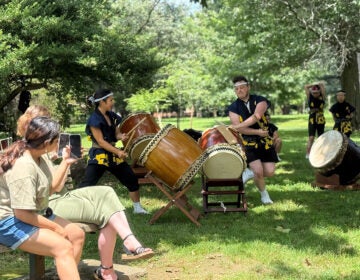In hunt for newest duck stamp, judges take a gander at 153 paintings
It may look like a duck and walk like a duck, but that doesn’t make it a duck stamp.
Five judges seated in the auditorium of the Academy of Natural Sciences at Drexel University, on the Parkway in Philadelphia, took quick, sharp looks at 153 duck paintings to give each a thumbs up or thumbs down. The winners go to the next round, until a single duck painting rises to the top.
In seconds, months of work go down the drain.
“It’s nail-biting,” said Garret Jacobs, formerly of Burlington, New Jersey, who now lives in Florida. He submitted a painting of a Canada goose to the 66th annual Federal Duck Stamp Contest, the only art contest held by the U.S. government.
“I’ve been nervous, butterflies in my stomach, ever since I flew into town,” he said. “It’s not something I want to relive over again.”
But Jacobs has relived that feeling over and over, every year since 1983 when he submitted his first duck painting to the contest. He has made it to the final round three times, but has never won. This year, his Canada goose did not move forward.
“It’s competition. My goal is to be the best. I didn’t get it this year. It may take me a few more years,” said Jacobs. “I’ll get there. I want to be the first African-American to win the duck stamp.”
The duck stamp is not a postage stamp. But if you intend to hunt waterfowl, you are required to buy a $25 federal stamp and affix it to your state-issued hunting license. Every year, artists vie to make the image gracing that stamp.
About 1.5 million stamps are sold every year to hunters and collectors, generating about $25 million for wildlife conservation. The duck stamp is one of the biggest sources of revenue for the U.S. Fish and Wildlife Service, used chiefly for buying conservation easements on millions of acres of private property.
Careers take flight with winning entries
There is no prize money for winning the contest, but it will guarantee the artist a career.
Joe Hautman of Minnesota, last year’s winner, has won five times. He is part of a duck stamp dynasty: he and his two brothers, Robert and Jim, have won the contest a total of 11 times.
“We’re not very good self-promoters. We’re not good at selling our own work or selling ourselves,” said Hautman, who was working as a post-doctoral fellow in physics at the University of Pennsylvania when he entered the contest the first time in 1992, and won.
“Nobody knew who I was. Nobody had a clue until I won the contest,” said Hautman. “Then, overnight, people knew my name, they wanted to buy prints from me. I met the president in the White House.”
The Hautman brothers were name-dropped by Joel and Ethan Coen in their film “Fargo” (1996), which featured a pregnant police investigator married to a duck artist. The Coen brothers and the Hautman brothers were childhood friends while growing up outside Minneapolis.
The contest and its winners have developed their own subculture of collectors, ornithologists, and artists. They can make for an odd bunch. A new documentary, “Million Dollar Duck” (debuting on Animal Planet Wednesday), follows six 2013 contestants as they try to anticipate the judges, outsmart each other with compositional style, and make a name for themselves in the small but intense world of competitive wildlife art.
“People can care about a basketball going through a hoop. You can make a drama out of anything,” said filmmaker Brian Davis. “Wildlife painting can seem really boring, but when you start peeling back the layers, and adding conservation ideas around the stamp, and the amount of time people put into it, it becomes really interesting.”
A first for the academy
The rules of the contest have been ironclad since 1934 when it was signed into law by President Franklin Roosevelt (Migratory Bird Hunting Stamp Act, 16 U.S.C. 718-718j, 48 Stat. 452). The contest has never before been held at the academy, despite its long relationship with the U.S. Fish and Wildlife Service.
Since 1978, the academy has housed the Fish and Wildlife’s official art collection. Several hundred paintings are stored at the academy, which has its own collection of several thousand pieces of wildlife art archived among its biological research specimens and texts.
“By having the contest here at the academy, it’s a wonderful coming together of scientific research, conservation, and art,” said senior fellow Bob Peck.
WHYY is your source for fact-based, in-depth journalism and information. As a nonprofit organization, we rely on financial support from readers like you. Please give today.









